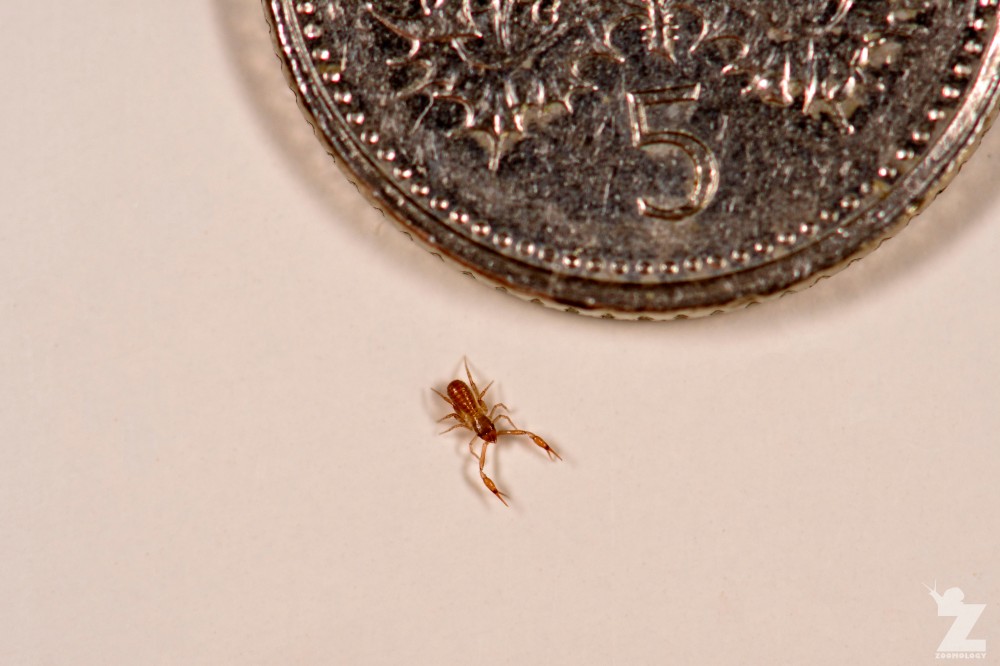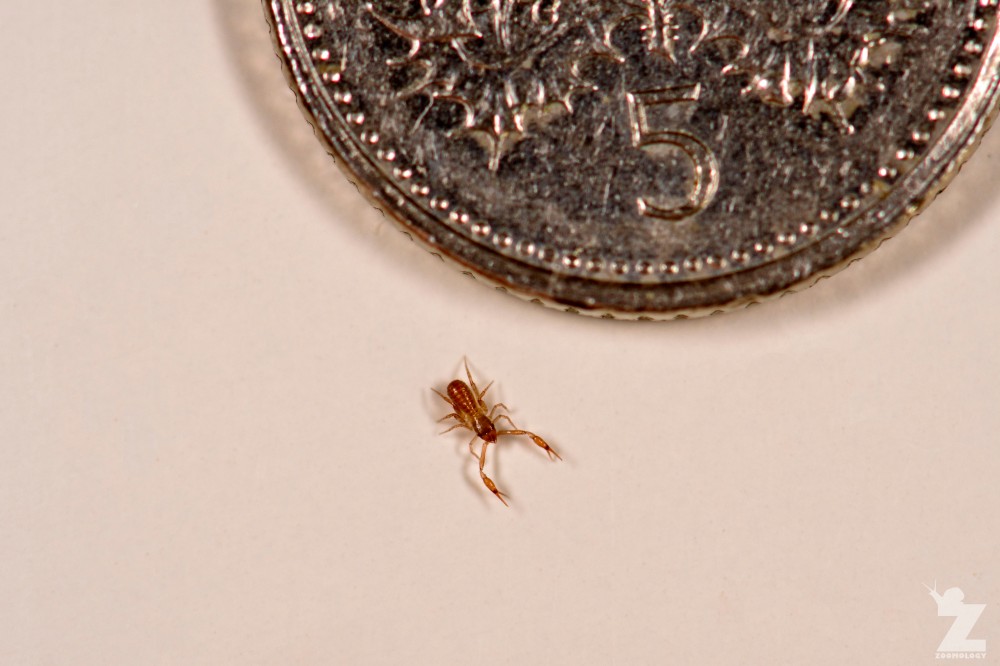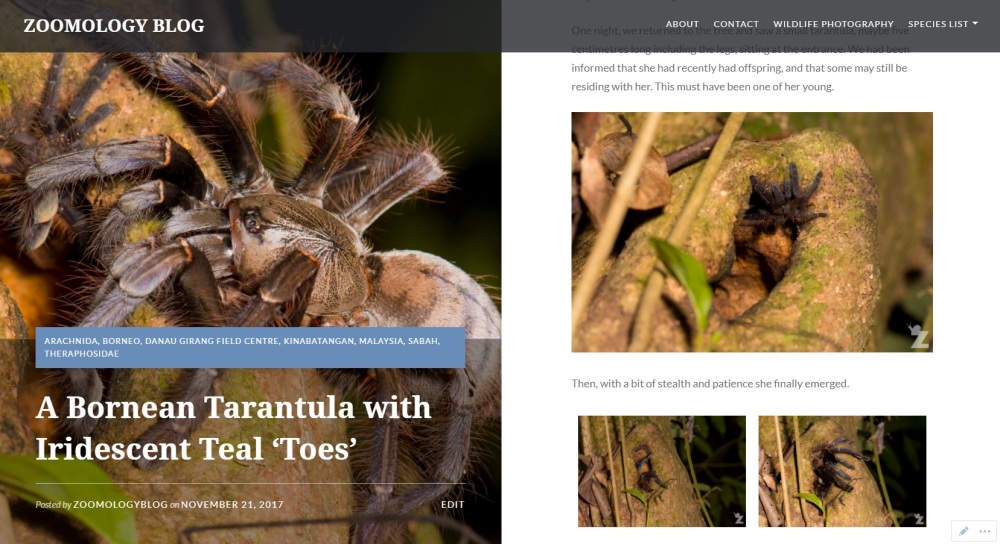After a long night of both dusk and dawn bat surveys, being home and about to hop in a hot shower was just what I had been wanting. I had not long put down my prescription glasses when I noticed a dark speck on the white grouting between the tiles that make up the walls of the shower. Squinting, I could just make out what looked like the world’s tiniest scorpion.
With a steady hand, a few small British coins as a size reference and the aid of my macro lens, I was able to get a little closer. Sure enough, I had been sharing my shower with a pseudoscorpion.
Click to zoom in
What are pseudoscorpions?
- Pseudoscorpions are arachnids (this class of animals also includes spiders, ticks, true scorpions)
- They belong to the order Pseudoscorpiones
- They have flat, pear-shaped bodies, and pincers
- They don’t have a tail like their true scorpion cousins
- They are very small, ranging in size from 2-8mm
How many species of pseudoscorpion are there?
- There are more than 3,300 different species of pseudoscorpion known across 430 genera, and they are found all over the globe
- In Britain, there are known to be 27 different species, 12 of which are quite common
- Entomologist, Liam Andrews, has identified our specimen as a Common Chthonid (Chthonius ischnocheles). This species is locally common, and is usually found under stones, bricks and other debris, as well as woodland soil and litter, occasionally in bird and other animal nests… and apparently sometimes in people’s showers!
How long have pseudoscorpions been around?
- The oldest known fossil pseudoscorpion dates back 380 million years to the Devonian period and has changed very little over this period closely resembling today’s pseduoscorpions in morphology
Are pseudoscorpions dangerous?
- No, not unless you are a springtail, mite or other tiny invertebrate prey!
- They are actually very beneficial, not only as integral parts of the ecosystem, but also because they eat clothes moth larvae, carpet beetle larvae, ants, mites, small flies and booklice that may enter your house
How do they capture their prey?
- Pseudoscorpions catch their prey with their pincers before injecting paralysing venom and then digestive fluids
- They then suck out the liquefied tissues much like a spider would
- Unlike spiders who have their venom glands in their mouth parts and scorpions who have their venom glands in their tails, most pseudoscorpions have their venom glands in their pincers
Where can I find a pseudoscorpion?
- Species have been found under tree bark and in tree hollows, beneath leaf and pine litter, within soil and under stones, in caves and at the seashore
- Cheiridium museorum is the species most commonly found in peoples homes in the UK. This species is known as a book scorpion and is associated with dusty books where they prey on booklice and dust mites
Did you know…
- Pseudoscorpions can spin silk from their jaws to make disk shaped cocoons for mating, moulting and waiting out cold weather
- The young pseudoscorpions ride on the mother’s back for a short while after hatching
- Some species are phoretic, meaning they grab a hold of a larger, sometimes flying host, and can hitch a ride!
Would you like to read about another of our Arachnid adventures?
Check out these blog posts.
A polkadot jumping spider in New Zealand:
An amazing spider mimicking an ant in Borneo:
A tarantula with iridescent ‘toes’:
References and Further Reading
Many thanks to Liam Andrews of the UK Pseudoscorpion Facebook Group for his corrections, pseuscorpion identification and useful information. Definitely visit the group if you have any pseuscorpion-related questions!
British Naturalist Association – Psuedoscorpions – http://www.bna-naturalists.org/guide10.pdf
(Retrieved 19 September, 2018)
Buglife – Pseudoscorpions – https://www.buglife.org.uk/bugs-and-habitats/pseudoscorpions
(Retrieved 19 September, 2018)
Chelifer.com – Pseudoscorpions, Chthonius ischnocheles, Common Chthonid – http://www.chelifer.com/?page_id=135
(Retrieved 26 September, 2018)
Chelifer.com – Pseudoscorpions, UK Species – http://www.chelifer.com/?page_id=81
(Retrieved 26 September, 2018)
UK Safari – Psuedoscorpions – http://www.uksafari.com/pseudoscorpions.htm
(Retrieved 19 September, 2018)
Western Australian Museum, Perth – Pseudoscorpions of the World, version 2.0. –http://www.museum.wa.gov.au/catalogues/pseudoscorpions (Harvey, M.S., 2011)
(Retrieved 26 September, 2018)










Glad it was only a “pseudo” in the shower! 😊
LikeLiked by 2 people
So was Tom!!!!! 😀
-Emma
LikeLiked by 1 person
Interesting! I’ve never seen that before.
LikeLiked by 2 people
I’d never seen one (knowingly) before I found one whilst sifting through leaf-litter at university. I remember being absolutely amazed by it. As is often the way, once you know they exist, you begin seeing them a lot more!
-Emma
LikeLiked by 1 person
Exactly!
LikeLiked by 1 person
How interesting. I would guess that being so tiny they are often overlooked.
LikeLiked by 2 people
Yes! Just as I was saying to Pam in reply to her comment above, they are so easy to overlook if you don’t know they are there. They are fascinating critters indeed.
-Emma
LikeLiked by 1 person
This is just TOO GOOD! I have to weave one of these into the bizarre tale unfolding on The Perils of Improbable Potholes. Maybe Sue, the Pseudo Scorpion will debate Vlad!
LikeLiked by 1 person
Hello A. Nonymous,
So happy that one of our critter observations has inspired a character! I can’t wait to meet Sue, the Pseudoscorpion, in one of your upcoming chapters. 😂 I have been reading your writing backwards – it has made for an even trippier adventure! Can’t wait to start reading them in the intended direction. Be back soon.
-Emma
P.S. Is it just me, or can I not comment on your posts?
LikeLiked by 1 person
Should be able to comment. However, I might have it set to “moderated” and need to process the queue. (Thanks for the reminder!)
LikeLiked by 1 person
No worries!
-Emma
LikeLike
Great photos and article! I’m going to be on the lookout for them now.
LikeLiked by 1 person